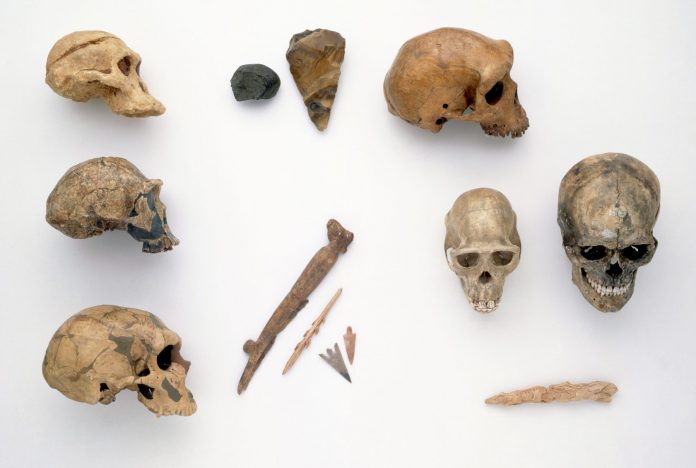
The evolution of humans and primates in Asia
Text YD Bar-Ness
Out on a limb
This is a story about our little branch on the tree of life. Let us journey out on a figurative limb, balancing our way along the branch we share with the primates, and then onto the smaller branch we call Homo. Thanks to advances in genetic technology, working in tandem with fragments of fossil evidence, we are starting to get a sense of where, geographically, this strand began.
The “tree of life” is a conceptual illustration of the interrelatedness of life, similar to the concept of the family tree, but grander in scale. This scientific endeavour is known as “taxonomy”, derived from two Greek words: taxis, which means order or arrangement, and nomos, which means law or science. Together, they form the branches of this elaborate tree structure.
In taxonomy, every group has a sister group – its closest relative. You could think of the sister group as the neighbouring branch. The branching point is their last common ancestor. We share a relatively recent common ancestor with apes and monkeys, a less recent ancestor with all mammals, and a distant ancestor with all other animals. If you journey into the past, you will find that all living organisms share a common ancestor.
Let’s see where humans are situated on this tree, and examine the research that seeks to determine when, and from where, these branches evolved. Where on Earth did modern humans evolve? Where did apes come into being? Who is our closest relative? To place any organism on the tree of life, there are three main lines of scientific inquiry: living anatomy, fossil anatomy, and genetic research.
Comparative Anatomy
The earliest efforts to place humanity on the tree of life followed the most obvious point of investigation: The shared anatomy of living organisms. It’s apparent that two different species of pine tree belong in the same category, and it’s clear that the squirrels of the world are related to one another. While there are some organisms that – superficially – resemble one aother (koalas and pandas, sharks and dolphins), careful study of specific anatomical features can help reveal the true relationship between species.
It’s become clear that we are most closely related to the great apes: the chimpanzee, gorilla, and orangutan. Anatomically, the differences are minor; we have almost exactly the same internal organs and remarkably similar skeletons. Tellingly, at various points, our vocabulary has hinted at these close relationships: 2,500 years ago, the Phoenicians of Libya encountered the “hairy men” of the West African coastline, and this is translated as “gorilla”. In the Bahasa Malay language, the word “orangutan” translates to “man of the forest”.
Fossil Findings
Looking at the anatomy of organisms alive on the planet today reveals only the narrowest sliver of time in the greater scheme of things. To travel back along the tree of life to its roots, we have depended heavily on fossil evidence – parts of living creatures that have been preserved in mineral form. By combining geological techniques with the precise measurements of anatomical features, we can enhance this model of the tree of life.
However, the farther back along the family tree you go, the less likely it is that any shred of fossil evidence has been found. Accessing fossils from the ancient past depends on a combination of a rare set of circumstances, such as appropriate burial in sea sand, ash, or river sediment, and subsequent preservation, and – even less likely – their discovery.
In the last 200 years, a number of fossil fragments, such as that of the “Java Man”, have been found, sparking new ideas about human and primate evolution, but these are often only tiny sections of a full skeleton. Much of our knowledge of human evolution comes from teeth, jawbones, and fragments of skull. Through the careful comparison of relative sizes and structure, palaeontologists have created hypotheses about the anatomy and lifestyle of these predecessors.
Genetics
Molecular biological research in the last few decades has revealed the underlying structure behind anatomical and fossil taxonomies, and has challenged various findings from fossil remains. Today, by comparing the information held within the DNA molecule, we are able to form direct and precise branching patterns for living species; when genetic material can be obtained from relatively recent fossils, we can map extinct lineages, too. Perhaps most intriguingly, genetic evidence has identified parts of our biological heritage from extinct human lineages.

Primates: From Asia to Africa
We begin walking outwards on the branch 55 million years ago, when the world was covered in forest. In what is now Hubei Province, China, a tiny tree-climbing animal less than 30 grams in mass died and was buried within lake sediments that would eventually mineralise. Here, the primates – including the lemurs, monkeys, and our own group, the apes – are first represented in the fossil record.
The tiny mammal, Archicebus achilles, was not one of our direct ancestors, but its remains are the nearest examples to the shared ancestor of all primates. These earliest primates migrated across the interlinked Eurasian–North American–African supercontinent. The sister group of the primates, the tree shrews and the flying lemurs, are still found in eastern Asia today, supporting fossil evidence that suggests an Asian origin for primates. Primates arrived in Africa 38 million years ago, and diverged into the groups of living primates today. The primates located in other regions passed into extinction. Around eight million years ago, our own lineage, the tribe Hominini, had split from monkeys – and then from gibbons, orangutans, and gorillas.
Shortly thereafter, about seven million years ago, our lineage Homo split from our sister group, the chimpanzees, of the genus, Pan. Conventionally, these two branches of tool-using apes are referred to as seperate genera, but scientific controversy wages on as to whether chimps are sufficiently similar to be included as members of Homo.
As we venture out onto the even smaller branch of the Hominini, we find ourselves at the limit of comparative anatomical evidence, and must rely on scattered fossil finds and genetic research. Taxonomic naming begins to fail us here, too. Genetic findings tell us that this branch subdivides and fuses into a braided network – a complex ancestry of interbreeding amongst lines of early humans that we may never be able to completely understand.
One strand contains the groups Australopithecus, Kenyanthropus, and Paranthropus, known from African fossils that are three million years old. This includes the famous skeleton known as “Lucy”; she, and other skeletons, have been given tentative species names, but their degree of interrelation is a matter of current debate.
Around 2.8 million years ago, a shared ancestor of all humans lived during a period of global climate change. Africa began drying out and grasslands started spreading across the landscape. This marks the beginning of the Homo branch, which includes extinct lineages of ancient humans that coexisted with modern humans. Of the many names that have been proposed for ancient humans, abundant fossils between two and 1.5 million years old have been found for the earliest member, Homo habilis, dubbed the “handy man”. They were followed by Homo erectus, the “upright man”, who lived from about two million years ago to only 70,000 years ago, and Homo heidelbergensis, our ancestors who lived less than a million years ago. About 200,000 years ago, our own recognisable lineage, Homo sapiens, appears in the African fossil record, and 100,000 years ago, groups began migrating outwards into Eurasia, possibly in several waves.
Dr Rainer Grün, Director and Inaugural Professor of Archaeogeochemistry at the Australian Research Centre of Human Evolution at Griffith University, contextualises the progress in the study of human evolution: “When I started my career, modern humans evolved in Africa around 50,000 years ago and migrated straight to Europe,” he says. However, it now seems that rather than occupying Ice Age Europe, modern humans turned east to migrate to China, Southeast Asia and down to Papua New Guinea and Australia, he explains.
Dr Grün adds that these early migrants encountered Homo erectus, as well as other human species, such as Homo floresiensis – and possibly some species that we have not even discovered yet. He expects that new fossil finds from Southeast Asia will make significant contributions to our understanding of human evolution.
In research circles, there has been a refinement of models of human evolution, including in Asia. Dr Colin Groves, Emeritus Professor in the School of Archaeology and Anthropology at Australian National University, explains: “There used to be a vague feeling that the human lineage arose in Africa. Then there was Homo erectus, known from just two sites or groups of sites in Asia [Zhoukoudian near Beijing, and Trinil, Sangiran and Ngandong in Central Java]. For all we knew, the locus of human evolution might have simply moved to eastern Asia, and then moved back again.”
Back then, the relationship of Asian Homo erectus to modern peoples in Asia and Australasia was not known, but now, the picture is much clearer. “The Chinese and Javanese fossils are different from each other and from their contemporaries in Africa, and were essentially sidelines as far as human evolution is concerned, although they show our ancestors dispersing far from Africa and occupying unfamiliar environments,” Dr Groves explains.
Like Us
Overlapping with our modern human time frame are other lineages of Homo that had left Africa, including the Neanderthals (known from across Eurasia), Flores Man, or “hobbits” (known from skeletons found in Indonesia), the Denisovans (known from DNA evidence from teeth and a finger-bone from a single cave in Siberia), and the Red Deer Cave People (known from bones in caves from Central China).
Modern humans mingled with Denisovans and Neanderthals, and with new genetic tools, we have been able to identify portions of the modern genome that come from these distinct groups. Recent research indicates a previously unknown population of early humans in Southeast Asia that connected with the first of modern humans to travel through Asia and on to Australia and New Guinea.
For Dr Michael Westaway, Head of Palaeoanthropology Research at the Australian Research Centre of Human Evolution at Griffith University, the discovery of Homo floresiensis – a hominin that seems to have so many characteristics that are pre-erectus – is perhaps the most exciting discovery in recent years. “It indicates that there was a likely pre-Homo erectus migration into the region,” he says.
Equally exciting is the discovery of a new species from Denisova, Siberia, recovered from a genome. The fact that the genomes of the Denisovans are carried in the first Australians and Papua people tells an important story about the age of the dispersal of the first modern humans through the region. Dr Westaway explains that this shows that the ancestors of the Asian populations as we know them today had not met the Denisovan people – but the ancestors of the Aboriginal Australians and people of Papua had.
The Red Deer Cave fossils are controversial. “The age of these fossils is very late, and there is really nothing in their morphology from the available publications that indicates they are beyond the range of what we see in Late Pleistocene Homo sapiens,” says Dr Westaway. We need to develop an understanding of who the Denisovans were, he says. The other great question is what happens to Homo erectus? “Here we have a species that some would argue is almost two million years old, and yet we really know nothing about its demise,” Dr Westaway explains. “Presumably, it has to do with the migration of Homo sapiens through Asia, but there is no record to suggest that the two overlapped.” What is certain is that DNA is providing us with insights that we could not have obtained with the fossil record alone.
No field of science is as intimately tied to our existence as the study of human evolution, but it is difficult to reconcile the shreds of fossil evidence with the mass of information from genetic studies. Technologies may provide us with new insights, but we should accept that our journey outwards on the tree of life passes through a region of complexly intertwined branches. We are all part of one vast family, and we share unknown ancestors. We will never meet these earliest of humans, but their legacy lives on – in us.
For more stories and photos, check out Asian Geographic Issue 122.










